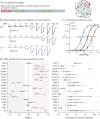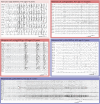Phenotypic Spectrum in Individuals With Pathogenic GABRG2 Loss- and Gain-of-Function Variants
- PMID: 40570274
- PMCID: PMC12202131
- DOI: 10.1212/WNL.0000000000213644
Phenotypic Spectrum in Individuals With Pathogenic GABRG2 Loss- and Gain-of-Function Variants
Abstract
Background and objectives: Variants in the GABRG2 gene encoding the γ2 subunit of the γ-aminobutyric acid type A (GABAA) receptor are associated with a spectrum of epilepsy phenotypes. These range from simple febrile seizures to more severe conditions, including developmental and epileptic encephalopathies (DEEs). Despite previous analyses suggesting that pathogenic variants may lead to loss-of-function (LoF) receptors, a correlation between functional analysis and clinical phenotypic diversity remains elusive. We, therefore, aimed to determine why variants in the GABRG2 gene can lead to highly diverse phenotypes.
Methods: We assembled a cohort of unreported probands carrying presumed pathogenic GABRG2 variants. Electroclinical information was systematically collected, and electrophysiologic measurements were conducted for missense variants to explore potential alterations in receptor function.
Results: We examined 44 individuals with 35 GABRG2 variants (18 null and 17 missense). Functional assessments of the missense variants revealed that 9 caused LoF and 3 caused gain-of-function (GoF). The remaining 5 did not alter receptor function and are likely not pathogenic. Based on functional analysis and electroclinical data, 37 affected individuals were categorized into 3 groups: null LoF, missense LoF, and GoF variants. Among 19 individuals with null variants, epilepsy was diagnosed in 13, with a median onset of 14 months. The remaining 6 of 19 only had febrile seizures. Developmental delay/intellectual disability (DD/ID) was observed in 1 of 19 and psychiatric features in 4 of 18. By contrast, all 12 individuals with missense LoF variants suffered from epilepsy with a median onset of 15 months. Most common epilepsy diagnoses were febrile seizures plus in 4 of 12 and DEE in 4 of 12. DD/ID affected 9 of 12, and psychiatric features were diagnosed in 8 of 12. Statistical comparisons revealed that null variants were associated with a milder phenotype than missense LoF variants. Finally, 5 of 6 individuals with GoF variants had DEE characterized by early infancy onset at 2 months and severe/profound DD/ID. The sixth individual exhibited mild DD/ID and hypotonia without seizures.
Discussion: Our findings indicate that the severity of disease associated with pathogenic GABRG2 variants depends on the functional consequences of the variants. Null variants are associated with a mild phenotype and missense LoF variants with an intermediate phenotype while GoF variants can lead to severe phenotypes.
Conflict of interest statement
The authors report no relevant disclosures. Go to
Figures





References
MeSH terms
Substances
LinkOut - more resources
Full Text Sources
Medical
